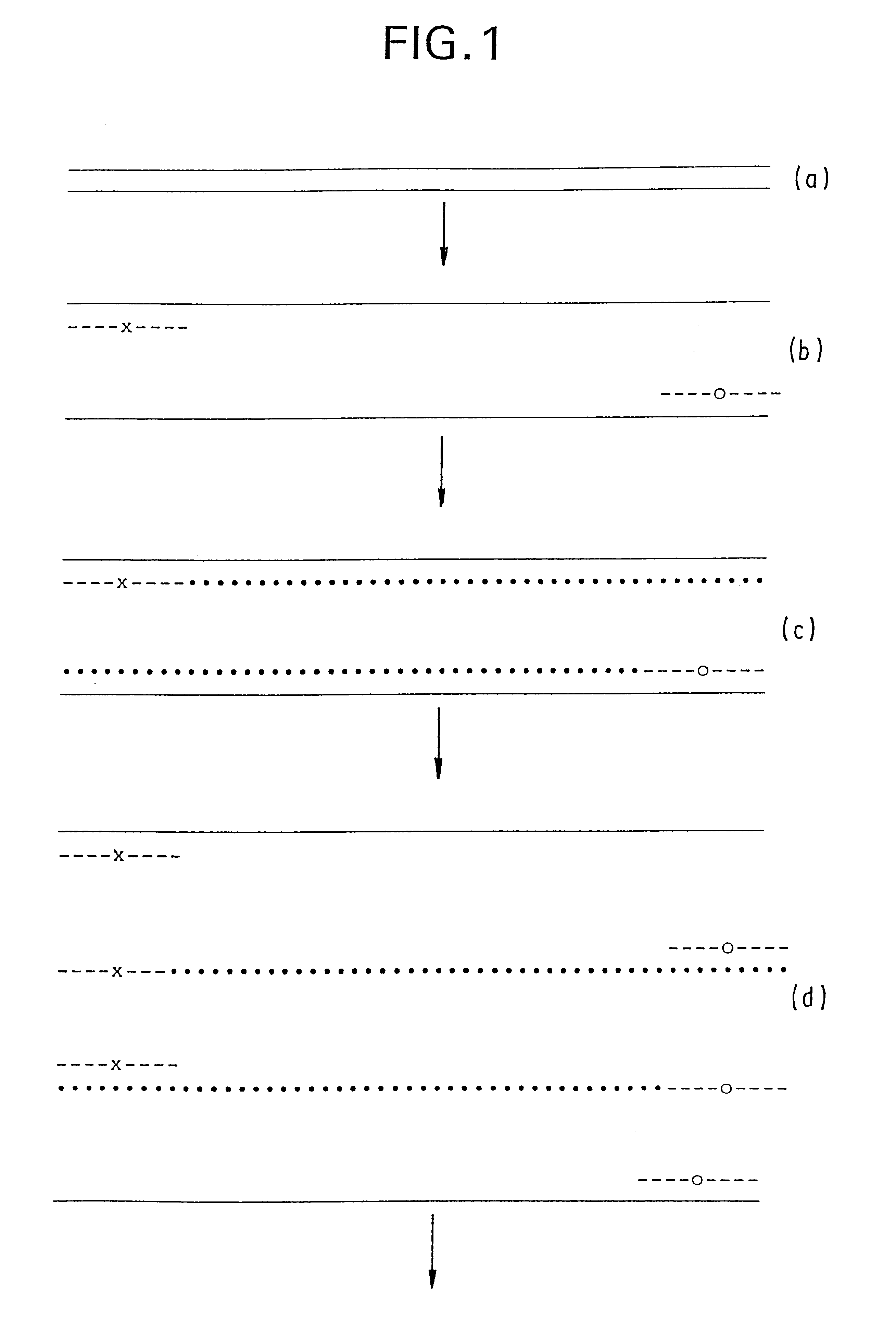Linked linear amplification of nucleic acids
- Summary
- Abstract
- Description
- Claims
- Application Information
AI Technical Summary
Benefits of technology
Problems solved by technology
Method used
Image
Examples
example 1
1,3 Propane Diol Blocks Primer Extension When Present in a Template
A template with or without a single nucleotide base containing a 1,3 propane diol moiety (designated as non-replicable element "X") and a primer complementary to the 3' end of the template were synthesized in order to demonstrate the ability of the 1,3 propane diol moiety to serve as a non-replicable element and halt DNA synthesis. The sequences synthesized are as follows:
DNA II GCTCCTTAGCATGGGAGAGTCTCCGGTTC SEQ ID NO:2 207 DNA II GCTCCCTTAXCATGGGAGAGTCTCCGGTTC SEQ ID NO:3 207X P12 GAACCGGAGACT SEQ ID NO:4
The primers and templates were annealed to form the following primer template complexes:
5' GCTCCCTTAGCATGGGAGAGTCTCCGGTTC TCAGAGGCCAAG 5' 5' GCTCCCTTAXCATGGGAGAGTCTCCGGTTC TCAGAGGCCA-AG 5'
The primer template complexes were then extended with various DNA polymerases (Klenow fragment of DNA Polymerase I, AmpliTaq polymerase (Perkin Elmer--Cetus Corp.), BST polymerase (Bio-Rad Laboratories, Hercules, Calif.) and Sequen...
example 2
Primers with Propane Diol-Containing Base Do Not Support PCR
Four oligonucleotides were prepared, two of which contained the non-replicable 1,3-propane diol moiety. The sequences were synthesized on an Eppendorf Ecosyn D300, automated DNA synthesizer with the MMT-propane diol phosphoramidite in the Z position. When entering the sequence into the synthesizer, a Z was introduced. The sequences are presented in the following table:
BGP-2 GGGTGGGAAAATAGACCATAG SEQ ID NO:5 22 BGP-2 GGGTGGGAAAATAGACCXATAG SEQ ID NO:6 22X BGP-1 GGCAGGAGCCAGGGCTGGGCATAAAAGTCA SEQ ID NO:7 30 BGP-1 GGCAGGAGCCAGGGCTGGGCATAAAXGTCA SEQ ID NO:8 30X
The sites of complementarity of the oligonucleotides in the human .beta.-globin gene (GenBank Locus HUMHBB) is shown in FIG. 12 (SEQ ID NO: 1).
In vitro amplification reactions were performed with various combinations of the four primers. Each reaction contained 100 ng of human genomic DNA, 6 pmol of each of two primers, in a standard PCR reaction buffer. Reactions were pl...
example 3
Propane Diol-Containing Primers Produce Specific DNA Fragments
The plasmid pH.beta..sup.A was mixed with propane diol- containing primers (BGP-1 30X and BGP-2 22X) or control primers (BGP-1 30 and BGP-2 22) not containing propane diol moieties. The primer / template mixtures were subjected to thermal cycling conditions of 94.degree. C. for 20 seconds to dissociate the double-stranded template, followed by 48.degree. C. for 20 seconds. After the final cycle, the reaction mixtures were incubated a further 5 minutes 40 seconds at 48.degree. C. to complete the primer extension reaction and anneal the single stranded DNA's. The reaction mixtures employing the propane diol-containing primers (according to the present invention) were cycled through 45 rounds of primer extension. The PCR reactions, utilizing the primers not containing propane diol moieties were cycled through 10 rounds of primer extension. The products of the reactions were subjected to electrophoresis on 1.5%; agarose (TBE bu...
PUM
 Login to View More
Login to View More Abstract
Description
Claims
Application Information
 Login to View More
Login to View More - R&D
- Intellectual Property
- Life Sciences
- Materials
- Tech Scout
- Unparalleled Data Quality
- Higher Quality Content
- 60% Fewer Hallucinations
Browse by: Latest US Patents, China's latest patents, Technical Efficacy Thesaurus, Application Domain, Technology Topic, Popular Technical Reports.
© 2025 PatSnap. All rights reserved.Legal|Privacy policy|Modern Slavery Act Transparency Statement|Sitemap|About US| Contact US: help@patsnap.com



